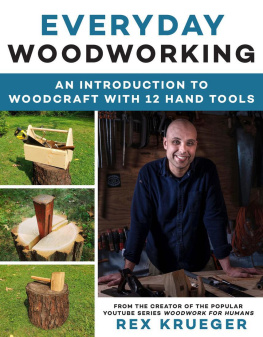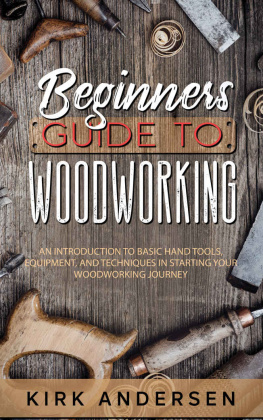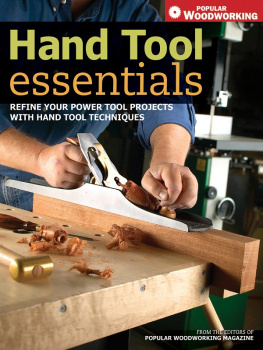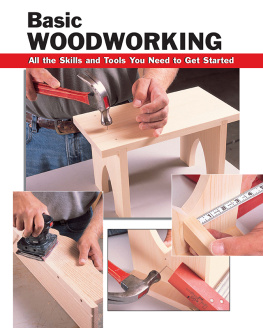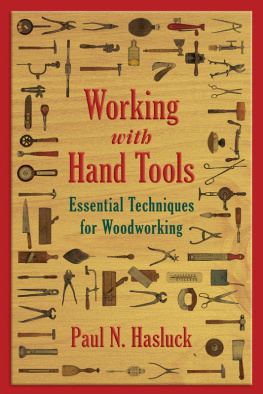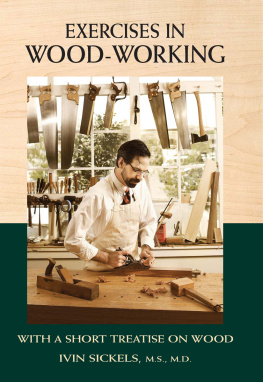Sign up for our newsletter and receive special offers, access to free content, and information on the latest new releases and must-have woodworking resources! Plus, receive a coupon code to use on your first purchase from ShopWoodworking.com for signing up.

Hand Tools are Popular
Hand tools are back baby! Whether shiny and new or old and well-used, more hand tools are finding their way into new woodworkers shops every day.
Have you noticed the most prominent and fastest-growing trend in woodworking these days? No, not midriff flannel shirts, silly! Im talking about the return to our old-school roots.
We are experiencing a resurgence of interest in human-powered wood manipulation, a hand-tool renaissance. Every day more woodworkers are unplugging their power tools and choosing their traditional, non-electric analogs. Have you leafed through any of the current woodworking magazines lately? You may have noticed not only an increase in the number of hand-tool articles and reviews, but also the number of hand-tool advertisements. Do a few web searches and youll find some popular blogs focused solely on hand-tool history, maintenance and use. In defiance of a hectic technology-driven world, it is clear that some of todays new woodworkers have the desire to hit the pause button and take some time to carve their own paths.
We resist the urge to stare into screens all day and instead retreat to the workshop to craft functional and beautiful creations with our own hands. Working wood can take some time and a woodworkers world seems to move at a slower pace than the rest of the populations. For us, the journey is as important, and sometimes more important, than the destination. So is it any wonder that when given the choice between a power tool and a hand tool, many woodworkers are drawn to the more modest option?
This is a very good thing for the craft. Hand-tool techniques are the foundation for the jobs that power tools do. The powered jointer is just an upside-down bench plane with a motorized blade. A band saw is the modern equivalent of the traditional frame saw. Sanders do the work previously assigned to smoothing planes. Our new tools and our old ones are so interconnected that it certainly couldnt hurt to have a strong working knowledge of hand tools, even if you intend to focus on power-tool woodworking. Understanding their hand-tool ancestors helps us get the most out of our power tools, and in some cases can help us identify where a modern power tool falls short and how we could overcome such limitations.
SUBSTANTIAL BENEFITS
Adding hand tools to a machine woodworking shop brings several substantial benefits:
- Hand tools are quieter.
- Hand tools are safer.
- Hand tools produce less dust.
- Hand tools improve accuracy.
- Hand tools can save you money.
- Hand tool projects have a special quality about them.
- Hand tools can be more gratifying.
I am a new parent, and Im very thankful that my hybrid woodworking routines allow me to get some work done while my son is sleeping. If your day job means you can only woodwork at night, or if you live in an apartment, the quiet nature of hand tools could make the difference between woodworking and not woodworking. The sound of a handsaw, the mallet taps on chisel, and the swoosh of a handplane are the only sounds that will emanate from your shop. Plus you have the added bonus of actually being able to hear the radio, or your own thoughts, or in my case, the baby monitor.
Hand tools are generally safer to use than power tools. Sure, you can still end up in the emergency room if you arent careful, but injuries with hand tools very seldom result in lost digits. And, great news for your lungs, the by-products of hand tools are shavings and chips that you can sweep up, not fine dust youll be inhaling and coughing up.
Hand tools improve accuracy because they remove small, controlled amounts of material with each stroke or pass. You can sneak up on the perfect fit. And should you go a stroke or two too far, you probably havent ruined the workpiece. Go a pass too fast or too far with a power tool and youll be starting over.
Hand tools also offer a potential economic benefit. By using scrapers and planes, youll consume less sandpaper. Good quality sandpaper doesnt come cheap, and with a hybrid approach youll use much less of it and youll likely need only to stock up on one or two grits. Additionally, because you arent producing nearly as much dust, you wont have to purchase as many of those expensive replacement bags for your dust extractor or shop vac. When your waste products are shavings and chips, a broom and dust pan becomes a viable cleaning solution.
Also, keep in mind that one of the great joys of hybrid woodworking is the ability to sneak up on the perfect fit. To facilitate this, most power-tool cuts will leave the workpieces oversized. So the chances of cutting a piece too short or making a tenon too small are minimized. That means less waste and fewer do-overs.
The final benefit to consider is the big X-factor, gratification. How much personal satisfaction you get from using hand tools is, well, personal. But I believe we all have the capacity to appreciate the magical feeling of achieving a positive result with a finely-tuned hand tool. And as much as I love to see great results from power tools, I have to admit that a high-quality hand-tool result is a little more special.
Based on all of these benefits, learning about and incorporating hand tools into the wood shop certainly sounds like a great idea. But dont get me wrong. I love my woodworking machines and my portable power tools, and I have no desire to become an exclusive hand-tool user. But I find there are a lot of good reasons to strategically incorporate hand tools into my power-tool shop.
So why doesnt every woodworker hold a ticket for a ride on the hand-tool train? To understand why, well need to consider the path of the modern woodworker. As popular as hand tools are, the current landscape still presents numerous obstacles, pitfalls and diversions that create confusion and can send the information-seeking woodworker down a rabbit hole.
POWER TOOLS FIRST, BUT WHY?
Todays new woodworker tends to follow a typical path involving the acquisition of basic power tools (table saw, drill, router, circular saw, jigsaw, and sander). I chat with thousands of woodworkers every year and I have the good fortune of hearing many origin stories about how they entered the craft. Some took shop class in high school, some recall lazy Sundays in the garage with grandpa, but most were influenced by a TV show or inspired after doing their first DIY or honey-do project. One thing nearly all of these people have in common is that their first tools are powered. This is actually the opposite of how it should be. In just about any discipline, one should always begin with the rudimentary tools first, and work up to the more complex gear. These days, that rarely happens.


